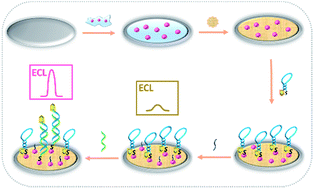当前位置:
X-MOL 学术
›
Anal. Methods
›
论文详情
Our official English website, www.x-mol.net, welcomes your feedback! (Note: you will need to create a separate account there.)
MicroRNA detection by an amplification-free biosensor based on controllable solid-state electrochemiluminescence quenched by charge transfer
Analytical Methods ( IF 3.1 ) Pub Date : 2017-09-22 00:00:00 , DOI: 10.1039/c7ay01724c Chang Liu 1, 2, 3, 4, 5 , Lin Wang 1, 2, 3, 4, 5 , Liping Lu 1, 2, 3, 4, 5 , Tianfang Kang 1, 2, 3, 4, 5
Analytical Methods ( IF 3.1 ) Pub Date : 2017-09-22 00:00:00 , DOI: 10.1039/c7ay01724c Chang Liu 1, 2, 3, 4, 5 , Lin Wang 1, 2, 3, 4, 5 , Liping Lu 1, 2, 3, 4, 5 , Tianfang Kang 1, 2, 3, 4, 5
Affiliation

|
Effective and sensitive microRNA detection is a great challenge. Most microRNA assays use an amplification strategy to obtain high sensitivity, which makes them complicated. Herein, we present a simple and amplification-free solid-state electrochemiluminescence (ECL) biosensor for the detection of miRNA based on high effective quenching by ferrocene and using N-butyldiethanolamine (BDEA) as a more effective co-reactant. Initially, the mixture of Nafion and Au nanoparticles (AuNPs) was cast onto the glassy carbon electrode (GCE) to form a Nafion–AuNPs film. The resulting electrode was then immersed into a solution of Ru(bpy)32+, where the solid-state Nafion–AuNPs/Ru(bpy)32+ could be obtained via electrostatic adsorption. The DNA molecular beacon, which was modified with thiol at one distal and the other was labeled with ferrocene (i.e., Fc-MB), was covalently attached to AuNPs on the ECL film through a Au–S bond. Afterwards, the remaining active sites of nonspecific adsorption were blocked with 6-mercapto-1-hexanol (MCH). When the target miRNA was present, it hybridized with the complementary part in the loop of Fc-MB and formed a double-stranded structure. This conformational change led the quencher away from the electrode, resulting in a remarkable increase in ECL intensity. Under the optimum condition, the ECL signal had a linear relationship with miRNA concentration ranging from 0.01 pM to 1 × 103 pM, with a limit of detection of 10 fM. Moreover, our biosensor showed remarkable specificity, outstanding reproducibility, good stability and excellent performance in real sample investigation with no amplification. Therefore, this developed strategy has great potential in early miRNA-related cancer diagnosis.
中文翻译:

通过可控的固态电化学发光通过电荷转移淬灭的无扩增生物传感器进行MicroRNA检测
有效且灵敏的microRNA检测是一个巨大的挑战。大多数microRNA分析使用扩增策略来获得高灵敏度,这使其变得复杂。本文中,我们提出了一种简单且无扩增的固态电化学发光(ECL)生物传感器,用于基于二茂铁的高效淬灭并使用N-丁基二乙醇胺(BDEA)作为更有效的共反应物来检测miRNA 。最初,将Nafion和Au纳米颗粒(AuNPs)的混合物浇铸在玻璃碳电极(GCE)上,以形成Nafion–AuNPs膜。然后将所得的电极浸入的Ru(联吡啶)中的溶液3 2+,其中固态的Nafion-的AuNP /吡啶钌3 2+可以得到通过静电吸附。DNA分子信标在一个末端被硫醇修饰,另一个在末端被二茂铁(即Fc-MB)标记,并通过Au-S键共价附着在ECL膜上的AuNPs上。然后,用6-巯基-1-己醇(MCH)封闭非特异性吸附的其余活性位。当存在靶标miRNA时,它与Fc-MB环中的互补部分杂交并形成双链结构。这种构象变化导致淬灭剂离开电极,导致ECL强度显着增加。在最佳条件下,ECL信号与miRNA浓度在0.01 pM至1×10 3之间呈线性关系。pM,检测极限为10 fM。此外,我们的生物传感器在无扩增的实际样品研究中显示出卓越的特异性,出色的可重复性,良好的稳定性和出色的性能。因此,这种开发的策略在与miRNA相关的早期癌症诊断中具有巨大的潜力。
更新日期:2017-09-22
中文翻译:

通过可控的固态电化学发光通过电荷转移淬灭的无扩增生物传感器进行MicroRNA检测
有效且灵敏的microRNA检测是一个巨大的挑战。大多数microRNA分析使用扩增策略来获得高灵敏度,这使其变得复杂。本文中,我们提出了一种简单且无扩增的固态电化学发光(ECL)生物传感器,用于基于二茂铁的高效淬灭并使用N-丁基二乙醇胺(BDEA)作为更有效的共反应物来检测miRNA 。最初,将Nafion和Au纳米颗粒(AuNPs)的混合物浇铸在玻璃碳电极(GCE)上,以形成Nafion–AuNPs膜。然后将所得的电极浸入的Ru(联吡啶)中的溶液3 2+,其中固态的Nafion-的AuNP /吡啶钌3 2+可以得到通过静电吸附。DNA分子信标在一个末端被硫醇修饰,另一个在末端被二茂铁(即Fc-MB)标记,并通过Au-S键共价附着在ECL膜上的AuNPs上。然后,用6-巯基-1-己醇(MCH)封闭非特异性吸附的其余活性位。当存在靶标miRNA时,它与Fc-MB环中的互补部分杂交并形成双链结构。这种构象变化导致淬灭剂离开电极,导致ECL强度显着增加。在最佳条件下,ECL信号与miRNA浓度在0.01 pM至1×10 3之间呈线性关系。pM,检测极限为10 fM。此外,我们的生物传感器在无扩增的实际样品研究中显示出卓越的特异性,出色的可重复性,良好的稳定性和出色的性能。因此,这种开发的策略在与miRNA相关的早期癌症诊断中具有巨大的潜力。



























 京公网安备 11010802027423号
京公网安备 11010802027423号